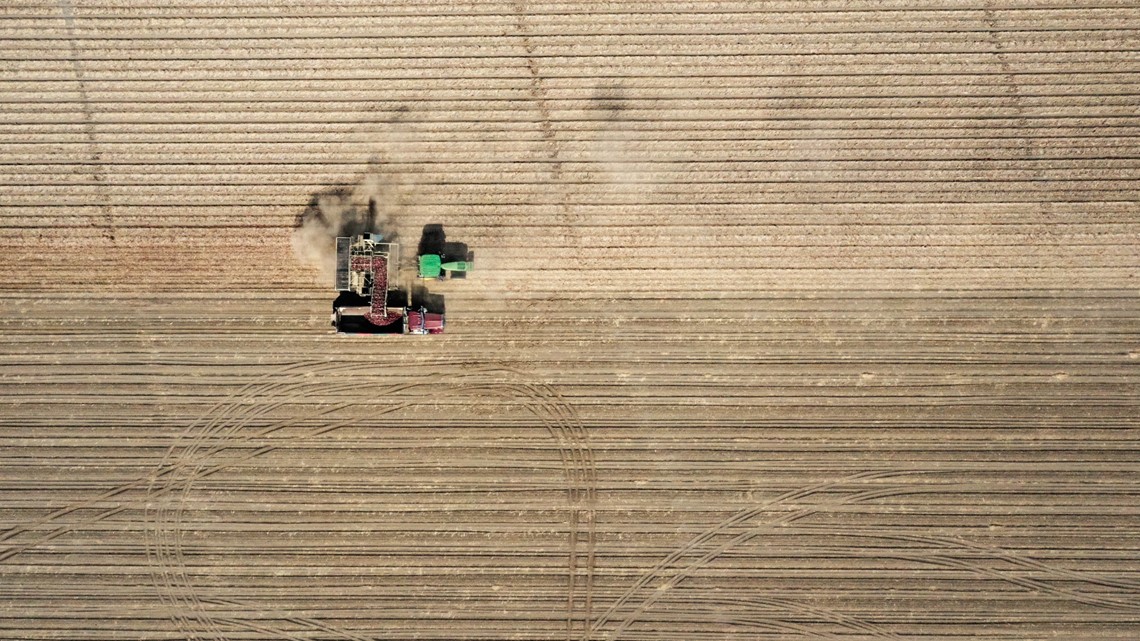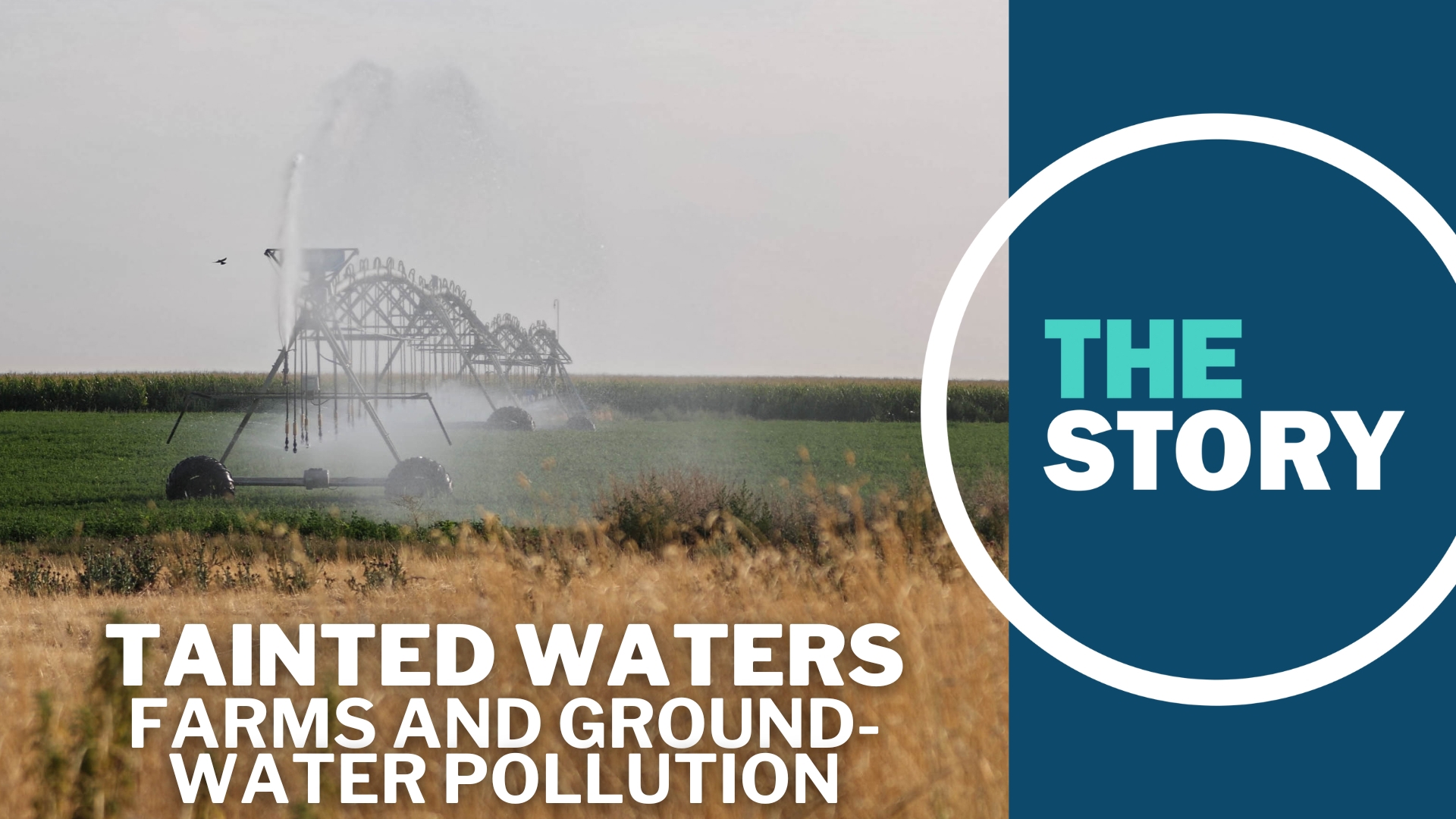SALEM, Ore. — In a region of northeastern Oregon known as the Lower Umatilla Basin, hundreds of the residential wells that families rely upon for water tap into a single large aquifer. And for decades, the state of Oregon has known that the water contains harmful levels of nitrates.
Nearly all of those nitrates are the result of food production in one form or another, with about 69% coming from farms in the region. While the pollution problem as a whole falls under the purview of several agencies — including the Oregon Department of Environmental Quality and the U.S. Environmental Protection Agency — farms are largely the domain of the Oregon Department of Agriculture.
Lisa Charpilloz Hanson is director of the ODA, heading an agency with 398 employees and a two-year budget of $157 million. Her department operates across Oregon and covers wide-ranging responsibilities, including food safety, animal health and livestock, predator control programs, lab services, and even the inspectors who check gas pumps to ensure they measure gallons correctly.
ODA also has a role in the regulation of water quality as it relates to farming. But the agency's overarching duty is to promote the state's agricultural industry even as it regulates aspects of it.
Charpilloz Hanson has a great deal of experience in the ODA, even if she hasn't been director for long. She was with the agency for 25 years, 16 of those as deputy director, before leaving in 2001 to work at the Oregon Watershed Enhancement Board. She returned in the fall of 2023, when Gov. Tina Kotek named her to head the department.
She also grew up on a farm, and now lives on her own farm in Clackamas County.
Charpilloz Hanson recently sat down with The Story's Pat Dooris to discuss one thing in particular: the Lower Umatilla Basin Groundwater Management Area, or LUBGWAMA. That's the state-designated area where testing has consistently shown dangerous levels of nitrates, and which officials have been monitoring for 30 years.
"We shouldn't be suffering here with poisonous water — endangering our children, having health issues with them or other people here who have issues to have more issues on top with this water," Charpilloz Hanson said.
30 years without improvement
Agriculture is the largest source of nitrates in the Lower Umatilla Basin. The chemical compounds are found in fertilizer, and they seep into the soil as farmers irrigate their fields, eventually making their way into the aquifer.
According to Charpilloz Hanson, there are 160,000 acres of irrigated land in the LUBGWAMA. Half of those acres are covered by permits that track how much water and nitrates are put on the land, but the other half are not. As a result, about 80,000 acres are still a black box when it comes to nitrate pollution.
"I think the important thing to note, in terms of Oregon's ag water quality program and the plans and the rules that go along with that, is the basis of the plan is no pollution to groundwater or surface water from agricultural activities," Charpilloz Hanson said. "There's a lot of diversity across the state, and there's a lot of diversity in the plans across the state because of the complexity of Oregon agriculture."
But in the Lower Umatilla Basin, Charpilloz Hanson admitted, the state's efforts to brainstorm a fix have not "yielded the results we would have wanted." In fact, nitrate concentrations have gotten worse.
However, the ODA director added that there is reason to be optimistic.
"I think we're in a really unique point in time with the work that you've done, with the work that the community has done, with the leadership of Governor Kotek and bringing people together to really look at this and say, 'Yes, more needs to be done, we need to do more,'" she said. "We need to do better and we need to work together collectively with everyone, because it's a complex ecosystem and we all need to be part of the solution. "


For better or worse, agriculture is the economic backbone of the rural communities in Umatilla and Morrow counties — so, despite the fact that state regulators have spent years suggesting voluntary changes to help fix the problem, they've always stopped short of issuing mandatory requirements to the unregulated farms.
"We have been through iterations in the (LUBGWAMA), working through different processes and different approaches, and like I said, it hasn't yielded the results that we would want to see in terms of lowering the nitrates," Charpilloz Hanson said. "I think, again, space and time and looking at it — we know we need to do something different. And right now I think all options are on the table. ODA has already started to do some work in that area. With very focused work, we have worked at doing a review of the water quality plans for the region."
Despite the fact that Oregon has been monitoring the Lower Umatilla Basin for 30 years, Charpilloz Hanson said, there hasn't been a clear assessment of the problem for the whole area — including the half of farms that aren't under a permit.
"I think we're really close to the action part," she added. "We don't have a registration system in place. We need to do more to understand what's going on, where it's happening and how it's happening."
Shying away from mandates
Across Oregon, Charpilloz Hanson said, there are 38 different agricultural water quality plans tailored to different types of farms and the places they're located. But when the Lower Umatilla Basin has a clear and present pollution problem, Dooris asked her, why isn't the state requiring all farms to track what they're putting on their fields?
"That's a great description of one of the options that I think we are considering," she replied. "As you consider all the options on the table for how we move forward, we need to do work in the community with our partners — the state agencies, the federal agencies, the local community — to put a plan in place that will work for that region."
Charpilloz Hanson reiterated that the state is currently "doing the evaluation" of agricultural practices in the region and will work to move forward "soon." She wasn't willing or able to offer a more specific prediction than that. More than likely, "soon" will not be nearly soon enough for the families relying on tainted wells.
"I feel the urgency and I know the urgency that's there in the community. When we were there last month in the community meeting, it was a really impactful opportunity in terms of hearing from community members and especially having conversations with community members afterwards," Charpilloz Hanson said. "We need to deal with the human health aspect of this first and foremost."
The ODA director visited Boardman in April, along with the director of the Oregon DEQ, to meet with community members. Charpilloz Hanson said she's pleased that the state is now delivering free, clean water to residents who know they have contaminated wells, and said that more testing needs to be done.


However, she's clearly cautious about lowering the boom on farms in the region, despite the fact that data points to them creating the lion's share of the problem. Voluntary actions haven't curbed the nitrate pollution problem, but Charpilloz Hanson is not committing to any widespread mandate for the region — because of the "diversity" of the area's agriculture, she said it will take a combination of different actions.
Theoretically, the state already requires that agricultural activities not pollute either groundwater, surface water, rivers or streams. In practice, that's obviously not being enforced.
"Traditionally we've focused on the surface water piece. This is the first time that we've had a strong focus on the groundwater and so we really are are learning from the work that we're doing with this assessment," Charpilloz Hanson said. "And building the foundation for for that, I think you know all options are on the table as we look at what we do going forward.
"Any combination of regulation and incentive-based (actions), it's going to be tricky to figure out what's going to work so we can support not only cleaning up the environment, but also the socio-economic basis of that community. Agriculture is the backbone of the community. It's what's grown that community in that region — food processing is important in the region, and so we need to find that sustainability stool going forward."
Charpilloz Hanson said that the ODA has broad powers to regulate farmers under agricultural water quality laws; many of her years with the agency were spent working on this very issue. But she said that she does think the recent attention to the issue may help push things forward that were impossible in the past.
"I am in a unique position today. It's a unique position to make a difference," she said. "It's a unique position to make a difference for the local community, the people that are impacted and to try and work collaboratively to find something that works for everyone; including Oregon agriculture and the food processing community so we don't lose the viability of that region."

